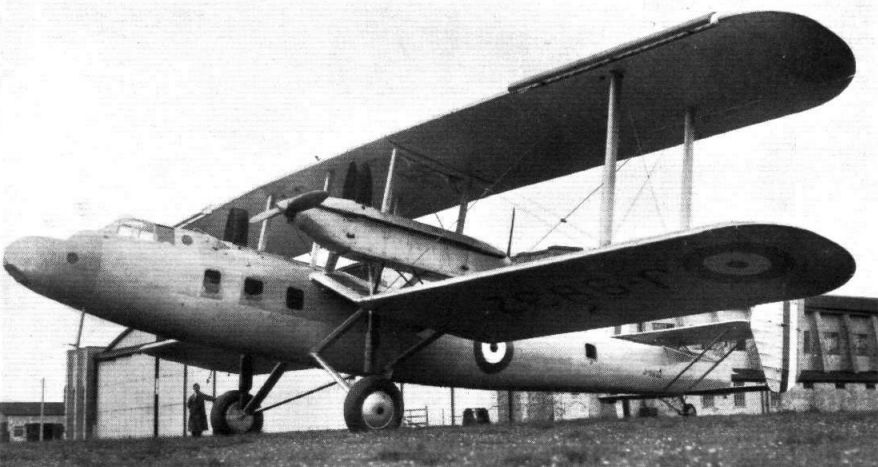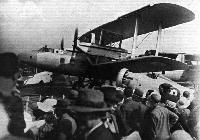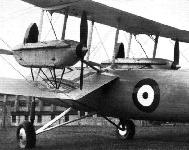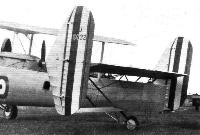
Описание
Страна : Великобритания
Год : 1932
Единственный экземпляр
Бомбардировщик/транспортный самолет, прототип
Gloster TC.33
В 1930 году группа конструкторов во главе с Генри Фолландом приступила к проектированию нового самолета, который должен был отвечать требованиям спецификации C.16/28 британского Министерства авиации на перспективный транспортный самолет/бомбардировщик, способный перевозить до 30 военнослужащих или равноценный по массе груз, или бомбовую нагрузку. Самолет получил обозначение Gloster TC.33 и в отличие от предложенного на тендер проекта Handley Page H.P.43 представлял собой абсолютно новую машину под новые 580-сильные двигатели Rolls-Royce Kestrel. Самолет конструкции Фолланда являлся цельнометаллическим бипланом, с бипланным хвостовым оперением с двумя килями и рулями направления, с неубирающимся шасси и силовой установкой с двумя двигателями Rolls-Royce Kestrel IIS и двумя Kestrel IIIS, размещенными попарно между крыльями бипланной коробки и приводившими во вращение толкающие и тянущие воздушные винты соответственно. Кабина - закрытая, в ней размещались пилот, второй пилот и штурман, плюс в носовой и в хвостовой частях фюзеляжа располагались позиции стрелков. Отличительными особенностями новой машины были внешние части верхнего и нижнего крыльев, имевшие стреловидность 7°, а также нижнее крыло, имевшее форму "обратной чайки". В ходе испытаний выявились различные недоработки, а взлетная дистанция с полной нагрузкой была настолько большой, что TC.33 не смог бы действовать с аэродромов британских ВВС того периода. На этой машине проект и завершился.
ТАКТИКО-ТЕХНИЧЕСКИЕ ХАРАКТЕРИСТИКИ
Gloster TC.33
Тип: бомбардировщик/транспортный самолет, прототип
Силовая установка: четыре 12-цилиндровых V-образных ПД Rolls-Royce мощностью по 580 л. с. (433 кВт), включая два ПД Kestrel 115 и два Kestrel HIS, приводившие во вращение толкающие и тянущие воздушные винты соответственно
Летные характеристики: максимальная скорость на высоте 3960 м - 227 км/ч; практический потолок 5790 м
Масса: пустого 8346 кг; максимальная взлетная 13102 кг
Размеры: размах крыла 28,98 м; длина 24,38 м; высота 7,82 м; площадь крыльев 231,60 м2
Вооружение: два 7,7-мм пулемета Lewis, по одному в носовой и хвостовой частях, плюс до 2994 кг бомб на подфюзеляжных держателях
Описание:
- Gloster TC.33
- Flight, June 1932
The Gloster Troop Carrier - Flight, November 1932
British Aircraft
Фотографии
-
Flight 1932-06 / Flight
Регистрационный номер: J9832 [8] -
Flight 1932-07 / Flight
Регистрационный номер: J9832 [8] DIGNITY AND IMPUDENCE: The Gloster Troop Carrier and the Vickers "Jockey" emerging from the aircraft park.
Другие самолёты на фотографии: Vickers Jockey / Type 151 - Великобритания - 1930
-
Flight 1932-06 / Flight
Регистрационный номер: J9832 [8] LOW FRONTAL AREA: This front view illustrates the clean design which characterises the Gloster Troop Carrier.
-
Мировая Авиация 141
Регистрационный номер: J9832 [8] Gloster TC.33 создавался под требования британских ВВС, испытывавших недостаток финансирования, а потому в нем должны были совмещаться бомбардировщик и транспортный самолет.
-
Air Pictorial 1955-05 / Photos by request
Регистрационный номер: J9832 [8] GLOSTER C.16/28. From time to time in future we shall be featuring in silhouette and descriptive form unusual and interesting aeroplanes of the past, in addition to new types . This month it is filling, in view of the company's impending fortieth anniversary, that we feature a Gloster aeroplane. In this case it is the Type 33, sometimes known as Goshawk. This should not be confused with the Gloster V racing seaplane, which also bore the same type number. The Type 33 was built to specification C.16/28 and serialled J9832. It was designed to carry thirty troops or alternative load over a range of 1,200 miles. Only one was built.
The prototype was completed in January 1931 and it is interesting to note that, because the hangar doors were low, the undercarriage had to be assembled in two trenches. The aircraft was winched in and out of the hangar by way of these trenches. -
Aeroplane Monthly 1974-09 / ??? - Hendon Pageantry 1920-37
Регистрационный номер: J9832 [8] "OLD FRIENDS": The "Gugnunc" and "Autogiro" aviating above the Gloster Troop Carrier.
The Handley Page “Gugnunc” climbs away steeply over the Gloster G.33 Goshawk troop transport/bomber, J9832, during the 1932 pageant.Другие самолёты на фотографии: Cierva/Avro C.19 - Великобритания - 1929Handley Page Gugnunc / H.P.39 - Великобритания - 1929
-
Flight 1932-06 / Flight
Регистрационный номер: J9832 [8] THE TANDEM ENGINE ARRANGEMENT: The four Rolls-Royce "Kestrel" engines (supercharged) are mounted in tandem pairs between the wings, the nacelles being, it will be seen, of good shape and smooth lines.
-
Flight 1932-06 / Flight
Регистрационный номер: J9832 [8] THE UNUSUAL TAIL UNIT: The horizontal tail surfaces are of sesquiplane form, while the large fins and rudders close in the ends of the tail.
-
Air Pictorial 1955-05 / Photos by request
GLOSTER C.16/28. Data : Manufacturer: The Gloster Aeroplane Company Limited, Hucclecote, Glos. Crew: four. Dimensions: span 94 fl. ; length approx . 78 ft. Weights: not known . Performance: maximum speed 146 m.p.h.; service ceiling 20,000 ft.; Power: four steam-cooled Rolls-Royce Kestrels each of 525 h.p.
- Фотографии








